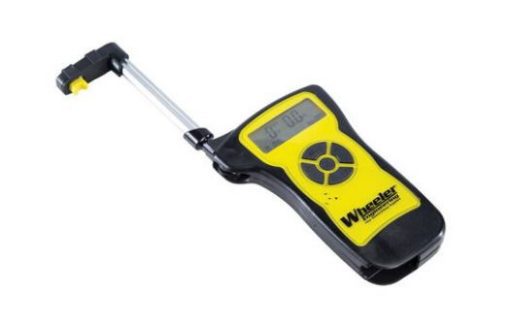This year alone, I have replaced at least a half dozen triggers. Each time, the manufacturer claimed a lighter pull, along with other improvements. It’s not that I don’t trust them, but it just makes sense to have on hand a way of testing the trigger pull. Fortunately, the good folks at Wheeler sent their Professional Digital Trigger Gauge, so I could validate manufacturer claims. New gauge in hand, I set out to check my triggers, and also to test the gauge itself.
The Gauge
Construction is a mix of black textured plastic, some shiny plastic, and soft-touch buttons. The swing-out arm is aluminum, and includes an adapter for triggers with a safety blade (dingus), like Glock, Savage, and Ruger. On the front are five buttons with their functions molded into the touch surfaces. Flip it over, and there’s a door for replacing the two AAA batteries.

Functions
On the back is a simple sticker that covers all the functions and modes. No need to consult your manual to use it. The center button powers it on and off. Going clockwise from the left button is the Units button, to change it from pounds to kg. Next is Mode, for changing the screen mode. On the right is the multi-function Delete button. And finally, at the bottom is the Enter for recording each pull (when doing an average).
Modes
The gauge has several different modes, making it useful for checking consistency over several pulls. Peak mode records the max reading until it’s either entered or deleted. AVG provides the average or all trigger pulls (for the session). MAX and MIN record the highest and lowest. N= the number of pulls, which is useful for averaging over a desired amount of pulls. Finally, LIVE gives you a live reading as you’re pulling the trigger.
In use
My preferred method is the AVG mode. Take a reading, hit Enter, and take another. Over the course of however many readings desired, it will display the minimum and maximum effort (up to 12 pounds) of pressure required. If you happen to get a faulty reading, tap the Delete button to reject it. When all readings have been taken and noted, holding the Delete button clears the memory. Despite sounding complex, it’s really simple to use.
Testing
With a stack of rimfire Rugers to choose from, I set about testing triggers from KIDD, Timney, Brimstone, Volquartsen, TandemKross, and even a Ruger BX factory trigger. Although the individual results would be best for another article, I’m happy to report that each trigger performed as expected. I also tried it on a few CZ pistols, an AK-47, Scorpion, and some others. Spoiler: All my triggers averaged pretty close to manufacturer specs. I mention this, because the PSAK-47 has a much different trigger than a CZ Shadow 2. The gauge had no problem with the these huge variances between firearms.
Conclusion
As an enthusiast checking triggers, the Professional Digital Trigger Gauge is a great tool. I can verify the trigger pull weight on all my firearms. Just as important, I can verify consistency from pull to pull. And I think that the MSRP of $64.99 is reasonable. As I do more reviews, it’s worth knowing that the trigger pull matches what is advertised. At the same time, I have been doing some customer builds not just for the site, but for some local enthusiasts. So it’s helpful to let them know exactly what they are getting with their trigger.
Comments? Questions? Have any of our readers tried out Wheeler Digital Trigger Gauge, or do you prefer another option? Feel free to share below.